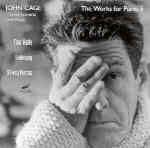Four Walls was the first large-scale collaboration between composer John Cage and choreographer Merce Cunningham. Conceived as a “dance-play” in two acts, Cunningham’s scenario and text depicted a dysfunctional American family and its progressive descent into madness. Using the white keys only, Cage provided a solo piano score following a rhythmic structure that incorporated specific mathematical durations, including time-lengths for both the script and the dancing. The work received its one and only performance on August 22, 1944, and was completely forgotten until pianist Richard Bunger rediscovered it in the late 1970s. At first Cage felt its expressive style unrepresentative of his work, but he ultimately allowed his publisher C. F. Peters to make it public after Margaret Leng Tan premiered it in New York.
Heard from an early 21st-century vantage point, Four Walls’ slow-moving chordal sections and frequent silences evoke Arvo Pärt’s “tintinnabular” minimalism, or perhaps some of Lamont Young’s repeating keyboard patterns in The Well-Tuned Piano. Percussive, low-register writing often suggests the dry-boned asceticism of Erik Satie’s Socrate, or what some of Cage’s prepared piano pieces might sound like without nuts, bolts, and erasers implemented in and on the piano’s strings.
Pianist Haydée Schwartz’s performance strikingly differs from Richard Bunger’s premiere recording and Margaret Leng Tan’s traversal on New Albion. For the most part she favors slower tempos and thicker keyboard voicings, helped by a distant microphone placement that adds dynamic and textural heft. She relates to her aforementioned colleagues in Cage as, say, Otto Klemperer does to George Szell in Beethoven.
Sometimes detail gets lost. In Section Nine, to cite one example, the percussive left-hand clusters dominate to the point where you can barely hear the right-hand melody, whereas Bunger and John McAlpine (Largo) are crystal clear. Then again, where else on disc will you find former Cream bass player extraordinaire Jack Bruce intoning the central, unaccompanied song? He sings quite sweetly, if a little rough around the edges since the heyday of “Sunshine of Your Love” and “White Room”.
Schwartz prefaces Four Walls with some delightful (and excellently played) early Cage fillers. Given all the psychobabble written on the subject of Cage, I would be remiss if I didn’t mention Don Gillespie’s straightforward, clear, informative, and well-written notes. This is worth hearing if you’re a Cage fan, but New Albion’s superior sonics plus Margaret Leng Tan’s sensitive, polished playing remain my points of reference. And try to find McAlpine’s splendid, out-of-print recording: it’s also a keeper.
































